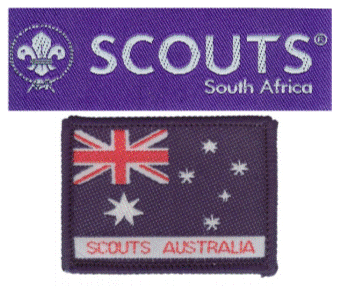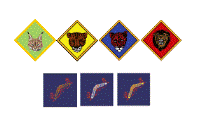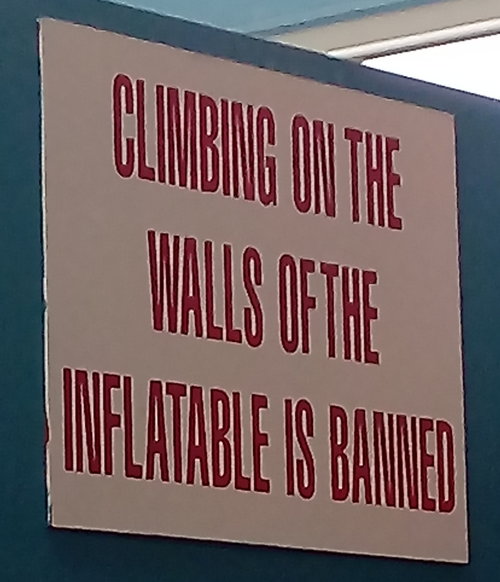I hope you find my writing and business tips and observations useful. My business and blog are dedicated to helping businesses communicate clearly and reach their potential.
Read, subscribe to my newsletter, enjoy!Tash
Who can read the sign?
We attended an indoor play centre recently for a child’s birthday party.
I spotted a sign on a wall opposite an inflatable slide, within the enclosed rock climbing area, that I think was missing the audience.
Where the sign was
The sign was up on a wall and printed in a large font so it should have been useful.
However, it was on an angle that made it hard to read except for by children rock climbing.
Surely putting it above the inflatable would have been more effective as it would be visible at the time you would be considering climbing up the forbidden walls.
What the sign said
Remembering this was in an indoor play centre where most of the patrons are under eight years of age, the sign was not written for the audience.
Apart from the very young children who can’t read at all, many youngsters would not be up to reading ‘inflatable’ and many would not know the word ‘banned’. Even for those who can understand the sign, it will be most effective if people get it instantly, without having to think about its meaning.
The inflatable is more known to children as the big slide, so that is the type of language they would be better using.
A much simpler sign would be “Do not climb up the slide”.
I think this is simpler and more effective, but also has a second meaning as it tells children not to climb up the slide itself, as well as not climbing on the support walls.
It is always important to know who you are aiming your communications at, and aim for clarity more than cleverness.
Using common ground for communicating
 Last night we had two South African cubs talk to our Australian cub pack. They showed us their uniforms and gave us an insight into how cubs is different in South Africa.
Last night we had two South African cubs talk to our Australian cub pack. They showed us their uniforms and gave us an insight into how cubs is different in South Africa.
At first glance, their uniform is very different to ours and not everyone would automatically link them both as cub uniforms, nor recognise all the badges. And it quickly became obvious that the Australian and South African opening ceremonies are different, too.
Yet when we spoke and we asked these cubs questions, our common language made it easy to understand each other and relate the differences.
It was also very nice to invest a new cub, explain that the world scout badge is worn by all scouts around the world and be able to point out that exact badge on two non-Australian uniforms to prove the point and link all the cubs.
Knowing the same foundations
Cubs and scouts are all based on the same principles wherever they are in the world, and each country adds its local flavour.
Yet all cubs know Akela is the leader of the pack, start the night with a Grand Howl and earn both interest and ‘progressive’ badges.
That common foundation made it easy for 8 to 10 year olds to understand each other.
A common understanding also helps business people communicate effectively.
It’s important to use the same language (jargon) when talking to suppliers and clients – do they know what a bleed or a keyword is? what do they mean by the word ‘benefit’ or ‘pension’? when will they deliver something promised ‘soon’ or ‘fast’?
Building a report, even if it is based on non-business connections, can also help business communications. Have you found it easier to work with someone who follows the same sport as you, grew up in the same area or likes the same music as you? This is one of the purposes of small talk when you start a business meeting or relationship.
Do you note and look for common ground with your business contacts? Do you remember those links so you can revisit them later?
Cub differences
For those who are curious, here are some of the differences between Aussie and South African cubs as discovered last night.
 South African cubs work towards progressive badges (gaining one about every 12 months) called the caracal, cheetah, leopard and lion badges. These badges are round and worn on the front of their shirt.
South African cubs work towards progressive badges (gaining one about every 12 months) called the caracal, cheetah, leopard and lion badges. These badges are round and worn on the front of their shirt.
Australian cubs work for their boomerangs (gaining one about every 12 months) called bronze, silver and gold. The badges are diamond-shaped and worn on the sleeve – put together with another badge they themselves form a diamond.
The highest South African cub badge is the Leaping Wolf; Australian cubs can earn the Grey Wolf.
South African Scouting consists of cubs (7 – 10), scouts (11 – 17 ) and rovers (18 – 30). Aussie scouts are Joeys (6 – 7), cubs (8 – 11), scouts (11 – 15), venturers (15 – 18) and rovers (18 – 26).
Both countries have interest badges for cubs to earn. South Africans earn red badges and Australians earn a green level 1 or red level 2 badge – all are worn on the sleeve.
Cubs in both countries are divided into sixes, each named by a colour. The cub looking after their six is called a sixer. An Australian sixer wears a badge saying ‘sixer’; a South African sixer has two yellow stripes on his or her pocket.
In Grand Howl, all cubs respond to the call of ‘pack, pack, pack’ and run into a circle. The differences are who calls out ‘cubs do your best’ and how the cubs form their parade circle.
South Africa apparently has 11 official languages, compared to Australia’s one, so that would make for an interesting discussion on communication, too!
Branding is in the details
Branding is a big subject, covering how you use your logo through to how you give a presentation. But did you know that the words you use in documents, on websites and in presentations also form part of your brand?
For instance, if your brand is to be young and funky, you don’t want web copy that reads “In our experience, prospective partnerships are best developed through a commonality of interests…”
Some factors to consider to ensure your written communications enhance your brand are:
- using language to suit the audience you want to attract
- use Australian spelling and conventions if your brand is ‘Australian owned’
- point of view – do you say ‘you’ or ‘clients’?
- how do you write the business name? Can you abbreviate it under certain circumstances?
- the tone – casual, formal, academic, legal
- the focus – business people, families, students, employers, professionals, etc
This can all come into preparing a style guide, too.



Recent Comments